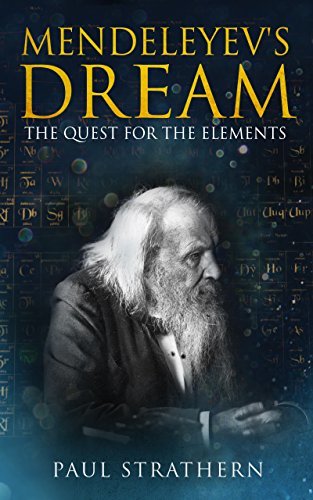Mendeleyev's Dream
Title: Mendeleyev's Dream

Author: Paul Strathern
Published in: 2001
Date read: 16th February 2010
Score: 4/5
Genre: History, Biography
Plot: (Warning, may contain spoilers):
"Mendeleyev's Dream: The Quest for the Elements" by Paul Strathern, published in 2000, is a fascinating non-fiction book that provides a comprehensive and engaging history of chemistry, framed by the life and pivotal discovery of the Russian scientist Dmitri Mendeleyev.
The book's central premise, as indicated by its title, refers to the famous anecdote that Dmitri Mendeleyev conceived the structure of the Periodic Table of Elements in a dream in 1869, after much tireless work on the problem of organizing the then-known elements. While the "dream" aspect is a powerful image, Strathern's book goes far beyond a simple biography of Mendeleyev.
Instead, Strathern takes the reader on an expansive intellectual journey that traces the human quest to understand the fundamental building blocks of matter from antiquity to the modern era. The narrative covers:
Ancient Philosophers: The book begins with the early speculations of Greek philosophers like Thales, Empedocles, and Aristotle, who posited theories about basic elements like earth, air, fire, and water.
Medieval Alchemy: Strathern then delves into the secretive and often mystical world of alchemy, highlighting its contributions (and missteps) to chemical knowledge, despite its primary goal of transmuting base metals into gold or discovering an elixir of immortality. This section introduces a colourful cast of characters and their often bizarre experiments.
The Dawn of Modern Chemistry: The narrative progresses through the Renaissance and the Enlightenment, exploring the breakthroughs made by figures like Robert Boyle, Antoine Lavoisier (who revolutionized the understanding of combustion and conservation of mass), and John Dalton (who proposed atomic theory).
The Quest for the Elements: Throughout these historical periods, Strathern emphasizes the painstaking work of various scientists and thinkers who gradually identified, isolated, and characterized individual elements, often through dangerous and crude experimental methods.
Mendeleyev's Life and Breakthrough: Woven through this historical tapestry is the compelling story of Dmitri Mendeleyev himself. Strathern depicts him not just as a brilliant mind but as a passionate and sometimes tempestuous individual. The book explores the intellectual climate of 19th-century chemistry and the various attempts by scientists to find a logical system for the elements before Mendeleyev's breakthrough. Mendeleyev's genius lay not just in arranging the known elements but in having the confidence to leave gaps for undiscovered elements and accurately predict their properties.
Strathern's writing is known for being accessible, entertaining, and erudite, making complex scientific concepts understandable for the lay reader. He populates his historical account with engaging anecdotes and mini-biographies of the scientists and philosophers involved, bringing their personalities and intellectual struggles to life. The book argues that Mendeleyev's Periodic Table was the culmination of thousands of years of human inquiry and marked chemistry's coming of age as a true science.
"Mendeleyev's Dream" is recommended by figures like Bill Gates, highlighting its broad appeal as an engaging history of scientific thought.
Comments:
I read this during my PGCE/teacher training when I began to broaden my understanding of how we got to the level of knowledge that we have now. It is a fascinating insight into alchemy and its evolution into chemistry.
Books that we've read by Paul Strathern (1):
Mendeleyev's Dream (2001)
This page was updated on: 28th July 2025

